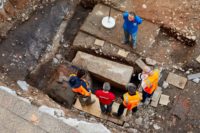 A Merovingian-era sarcophagus dating to the 7th century has been discovered in Cahors, Lot Department, southwestern France. Department archaeologists were excavating the courtyard of a public building in anticipation of future construction when they unearthed a large limestone coffin. The rectangular sarcophagus was topped with a four-sided gabled lid and was unbroken. The lid was still sealed to the box, its mortar joint unbroken. The find is unprecedented and of great significance to archaeologists because little is known about Merovingian Cahors.
A Merovingian-era sarcophagus dating to the 7th century has been discovered in Cahors, Lot Department, southwestern France. Department archaeologists were excavating the courtyard of a public building in anticipation of future construction when they unearthed a large limestone coffin. The rectangular sarcophagus was topped with a four-sided gabled lid and was unbroken. The lid was still sealed to the box, its mortar joint unbroken. The find is unprecedented and of great significance to archaeologists because little is known about Merovingian Cahors.
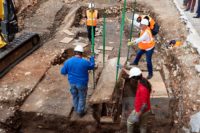 Archaeologists passed an endoscope through a crack in the stone to establish whether the sarcophagus’ contents were intact. They confirmed that skeletal remains were undisturbed inside the coffin before attempting to open the heavy lid. On Tuesday, August 13th, the limestone lid was strapped to a mechanical digger and carefully raised.
Archaeologists passed an endoscope through a crack in the stone to establish whether the sarcophagus’ contents were intact. They confirmed that skeletal remains were undisturbed inside the coffin before attempting to open the heavy lid. On Tuesday, August 13th, the limestone lid was strapped to a mechanical digger and carefully raised.
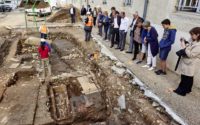 Forensic anthropologists from the National Institute for Preventive Archaeological Research (INRAP) worked with the Lot archaeologists to excavate and examine the burial. Initial analysis found the remains belonged to an elderly woman with the tell-tale lesions of osteoarthritis on her bones. There were no grave goods inside the coffin which is a common feature of Christian burials.
Forensic anthropologists from the National Institute for Preventive Archaeological Research (INRAP) worked with the Lot archaeologists to excavate and examine the burial. Initial analysis found the remains belonged to an elderly woman with the tell-tale lesions of osteoarthritis on her bones. There were no grave goods inside the coffin which is a common feature of Christian burials.
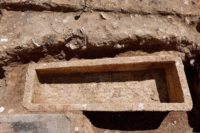 The find site is believed to have been on the property of a monastery founded by Desiderius (aka Didier) of Cahors, a 7th century aristocrat with close ties to Merovingian royalty who in his role as bishop of Cahors built multiple churches and monasteries in the area. Desiderius was renown for building in the Roman style — cut stone blocks rather than wood, wattle and daub — and he founded at least one convent for women. The sarcophagus appears to have been placed in a passageway (possibly the cloister), an indication that she must have been someone of importance.
The find site is believed to have been on the property of a monastery founded by Desiderius (aka Didier) of Cahors, a 7th century aristocrat with close ties to Merovingian royalty who in his role as bishop of Cahors built multiple churches and monasteries in the area. Desiderius was renown for building in the Roman style — cut stone blocks rather than wood, wattle and daub — and he founded at least one convent for women. The sarcophagus appears to have been placed in a passageway (possibly the cloister), an indication that she must have been someone of importance.
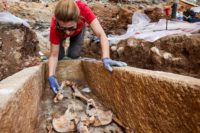 The bones have been removed from the sarcophagus and will be studied further at an INRAP laboratory. The remains will be radiocarbon dated to narrow down when the woman died. The preliminary dating to the 7th century is based on layer archaeology. Ongoing excavations have found pottery from the period and what is believed to be the remains of an old kitchen.
The bones have been removed from the sarcophagus and will be studied further at an INRAP laboratory. The remains will be radiocarbon dated to narrow down when the woman died. The preliminary dating to the 7th century is based on layer archaeology. Ongoing excavations have found pottery from the period and what is believed to be the remains of an old kitchen.
The sarcophagus and its lid are destined for the Musée de Cahors Henri-Martin, currently closed for renovations with reopening scheduled for early 2020. The museum is named after impressionist painter Henri-Jean Guillaume Martin and is known for its collection and temporary exhibition of work by artists from the 20th century to the present, but it also has a significant collection of archaeological artifacts from the region.